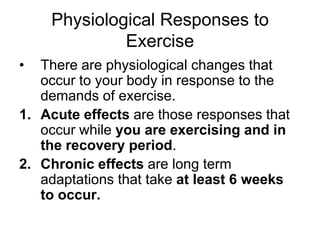
Training adaptations
- 1. Physiological Responses to Exercise There are physiological changes that occur to your body in response to the demands of exercise. Acute effects are those responses that occur while you are exercising and in the recovery period. Chronic effects are long term adaptations that take at least 6 weeks to occur.
- 2. Acute responces of exercise on the body (Immediate) Increased Heart Rate Increased Respiration Rate Increased Stroke Volume Increased Cardiac Output-Q Increased VO2 Increased Tidal Volume Increased Systolic Blood Pressure Increased Blood to working muscles
- 3. Increased Heart Rate When you exercise your heart rate (beats per minute) goes up to increase the supply of oxygen to your working muscles.
- 4. Increased Respiration Rate Respiratory rate is the number of breaths taken in one minute. During exercise amounts of carbon dioxide increases as it is a waste product and the respiratory rate goes up to increase oxygen and decrease carbon dioxide.
- 5. Increased Stroke Volume Stroke volume is the amount of blood pumped out of your left ventricle with each beat of the heart. This goes up to increase oxygen supply to working muscles.
- 6. Increased Cardiac Output-Q Cardiac output is the amount of blood pumped out of the left ventricle in 1 minute. Q=stroke volume x heart rate. Q=SV x HR
- 7. Increased VO2 Oxygen uptake (VO2) is the amount of oxygen that is taken up and used by the body to produce energy.
- 8. Increased Tidal Volume Tidal volume is the size of each breath and this increases with exercise as the body tries to increase oxygen flow to the blood.
- 9. Increased Systolic Blood Pressure Systolic blood pressure is the pressure as the left ventricle ejects blood into the aorta. Diastolic is the pressure in the arteries. Only the systolic pressure increases during exercise.
- 10. Increased Blood to working muscles Due to increased need for O2 during exercise blood is distributed more where it is required in working muscles.
- 11. Fitness Generally: “Fitness is a measure of the body’s ability to complete activities necessary for everyday life effectively and efficiently” (Hodgson, 2001) In the Sporting Context: “ … is a person’s physiological capability to perform a specific physical task or set of tasks”(Sherriff, 2001)
- 12. Who is fit?
- 13. Who is fit?
- 14. Who is fit?
- 15. Adaptation Physiological gain will occur only with regular exercise Adaptation depends on challenging the physical capability beyond a minimum threshold level (Overload)
- 16. Physiological effects to Exercise There are physiological changes that occur to your body in response to the demands of exercise. Acute effects are those responses that occur while you are exercising and in the recovery period. Chronic effects are long term adaptations that take at least 6 weeks to occur.
- 17. Chronic effects of exercise on the body - Adaptations Increased O2 carrying capacity of blood Increased blood supply as increased capillaries Increased number of blood vessels Lungs can take in and distribute more O2 Increased heart size (Cardiac hypertrophy) Decreased resting heart rate Increased Stroke volume at rest More glycogen stored in muscle Increased muscle size and strength
- 18. Increased O2 carrying capacity of blood This is due to the increase in plasma, haemoglobin as well as increases in blood vessels etc…and overall greater efficiency.
- 19. Increased number of blood vessels Efficiency is also improved as the number of blood vessels is increased. Particularly the capillaries where gaseous exchange takes place.
- 20. Lungs can take in and distribute more O2 Increased VO2 Max. This occurs due to increased tidal volume as well as improved ability to attract O2 from the alveoli onto the red blood cells.
- 21. Increased heart size (Cardiac hypertrophy) The size of the heart increases. For endurance the chambers get larger (particularly the left ventricle) and for non endurance the thickness of the ventricle walls increases.
- 22. Decreased resting heart rate Your resting heart rate decreases with fitness due to greater efficiency of systems.
- 23. Increased Stroke (SV) Volume at rest The heart develops larger chambers and/or thicker walls and improved efficiency. Therefore the stroke volume increases and this relates to the decrease in resting heart rate. Increased Cardiac Output (Q) Q = SV x HR
- 24. More glycogen stored in muscle Greater amounts of fuel are stored for use in endurance events. (For non-endurance ATP and CP stores are increased.
- 25. Increased muscle size and strength In non-endurance athletes the size of the muscle is increased due to hypertrophy of fast twitch fibres, in endurance athletes, increased numbers of capillaries, increased strength in connective tissues eg tendons, ligaments.